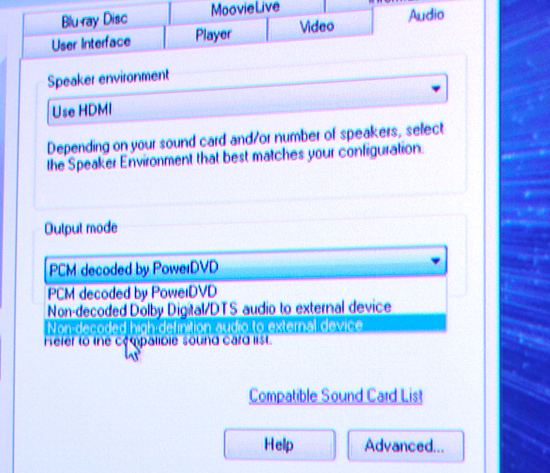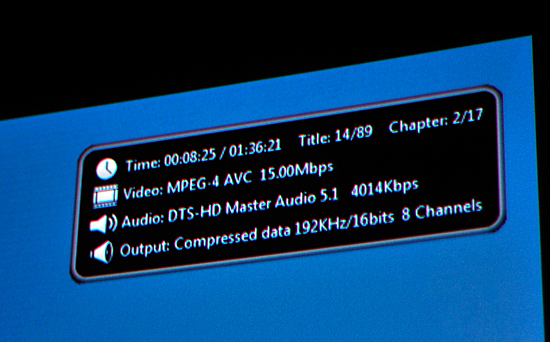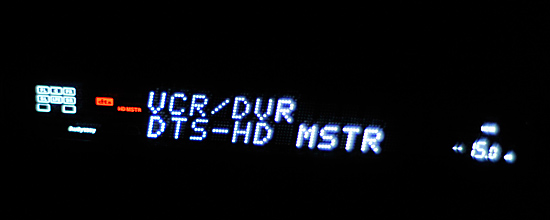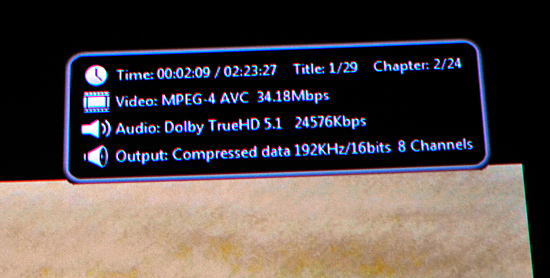AMD's Radeon HD 5870: Bringing About the Next Generation Of GPUs
by Ryan Smith on September 23, 2009 9:00 AM EST- Posted in
- GPUs
The Race is Over: 8-channel LPCM, TrueHD & DTS-HD MA Bitstreaming
It's now been over a year since I first explained the horrible state of Blu-ray audio on the PC. I'm not talking about music discs, but rather the audio component of any Blu-ray movie. It boils down to this: without an expensive sound card it's impossible to send compressed Dolby TrueHD or DTS-HD Master Audio streams from your HTPC to an AV receiver or pre-processor. Thankfully AMD, Intel and later NVIDIA gave us a stopgap solution that allowed HTPCs, when equipped with the right IGP/GPU, to decode those high-definition audio streams and send them uncompressed over HDMI. The feature is commonly known as 8-channel LPCM support and without it all high end HTPC users would be forced into spending another $150 - $250 on a sound card like the Auzentech HomeTheater HD I just recently reviewed.
For a while I'd heard that ATI was dropping 8-channel LPCM support from RV870 because of cost issues. Thankfully, those rumors turned out to be completely untrue. Not only does the Radeon HD 5870 support 8-channel LPCM output over HDMI like its predecessor, but it can now also bitstream Dolby TrueHD and DTS-HD MA. It is the first and only video card to be able to do this, but I expect others to follow over the next year.
The Radeon HD 5870 is first and foremost a card for gamers, so unless you're building a dual-purpose HTPC, this isn't the one you're going to want to use. If you can wait, the smaller derivatives of the RV870 core will also have bitstreaming support for TrueHD/DTS-HD MA. If you can't and have a deep enough HTPC case, the 5870 will work.
In addition to full bitstreaming support, the 5870 also features ATI's UVD2 (Universal Video Decoder). The engine allows for complete hardware offload of all H.264, MPEG-2 and VC1 decoding. There haven't been many changes to the UVD2 engine; you can still run all of the color adjusting post-processing effects and accelerate a maximum of two 1080p streams at the same time.
ATI claims that the GPU now supports Blu-ray playback/acceleration in Aero mode, but I found that in my testing the UI still defaulted to basic mode.
To take advantage of the 5870's bitstreaming support I had to use a pre-release version of Cyberlink's PowerDVD 9. The public version of the software should be out in another week or so. To enable TrueHD/DTS-HD MA bitstreaming you have to select the "Non-decoded high-definition audio to external device" option in the audio settings panel:

With that selected the player won't attempt to decode any audio but rather pass the encoded stream over HDMI to your receiver. In this case I had an Integra DTC-9.8 on the other end of the cable and my first test was Bolt, a DTS-HD MA title. Much to my amazement, it worked on the first try:

No HDPC errors, no strange player issues, nothing - it just worked.

Next up was Dolby TrueHD. I tried American History X first but the best I could get out of it was Dolby Digital. I swapped in Transformers and found the same. This ended up being an issue with the early PowerDVD 9 build, similar to issues with the version of the player needed for the Auzentech HomeTheater HD. Switching audio output modes a couple of times seemed to fix the problem, I now had both DTS-HD MA and Dolby TrueHD bitstreaming from the Radeon HD 5870 to my receiver.


One strange artifact during my testing was the 5870 apparently delivered 1080i output to my JVC RS2 projector. I'm not exactly sure what went wrong here as 1080p wasn't an issue on any other display I used. I ran out of time before I could figure out the cause of the problem but I expect it's an early compatibility issue.


I can't begin to express how relieving it is to finally have GPUs that implement a protected audio path capable of handling these overly encrypted audio streams. Within a year everything from high end GPUs to chipsets with integrated graphics will have this functionality.










327 Comments
View All Comments
Wreckage - Wednesday, September 23, 2009 - link
Hot, loud, huge power draw and it barely beats a 285.A disappointment for sure.
SiliconDoc - Thursday, September 24, 2009 - link
Thank you Wreckage, now, I was going to say draw up your shields, but it's too late, the attackers have already had at it.--
Thanks for saying what everyone was thinking. You are now "a hated fanboy", "a paid shill" for the "corporate greedy monster rip off machine", according to the real fanboy club, the ones who can't tell the truth, no matter what, and prefer their fantasiacal spins and lies.
Zstream - Wednesday, September 23, 2009 - link
They still allow you to post?yacoub - Wednesday, September 23, 2009 - link
He's right in the first sentence but went all fanboy in the second.Griswold - Wednesday, September 23, 2009 - link
Not really, he's a throughbred fanboy with everything he said. Even on the "loud" claim compared to what previous reference designs vom ATI were like...SiliconDoc - Wednesday, September 30, 2009 - link
So if YOU compare one loud design of ati's fan to another fan and as loud ati card( they're all quieter than 5870* but we'll make believe for you for now),
and they're both loud, anyone complaining about one of them being loud is "an nvidia fanboy" because he isn't aware of the other loud as heck ati cards, which of course, make another loud one "just great" and "not loud". LOL
It's just amazing, and if it was NV:
" This bleepity bleep fan and card are like a leaf blower again, just like the last brute force monster core power hog but this **tard is a hurricane with no eye."
But since it's the red cards that are loud, as YOU pointed out in the plural, not singular like the commenter, according to you HE's the FANBOY, because he doesn't like it. lol
ULTIMATE CONCLUSION: The commenter just told the truth, he was hoping for more, but was disappointed. YOU, the raging red, jumped his case, and pointed out the ati cards are loud "vom" prior.. and so he has no right to be a big green whining fanboy...
ROFLMAO
I bet he's a "racist against reds" every time he validly criticizes their cards, too.
---
the 5870 is THE LOUDEST ATI CARD ON THE CHART,AND THE LOUDEST SINGLE CORE CARD.
--
Next, the clucking rooster will whiplash around and flap the stubby wings at me, claiming at idle it only draws 27 watts and is therefore quiet.
As usual, the sane would them mention it will be nice not playing any 3d games with a 3d gaming card, and enjoying the whispery hush.
--
In any case:
Congratulations, you've just won the simpleton's red rooster raving rager thread contest medal and sarcastic unity award.(It's as real as any points you've made)
Anyhow thanks, you made me notice THE 5870 IS THE LOUDEST CARD ON THE CHARTS. I was too busy pointing out the dozen plus other major fibboes to notice.
It's the loudest ati card, ever.
GourdFreeMan - Wednesday, September 23, 2009 - link
I thought the technical portion of your review was well written. It is clear, concise and written to the level of understanding of your target audience. However, I am less than impressed with your choice of benchmarks. Why is everything run at 4xAA, 16xAF? Speaking for most PC gamers, I would have maxed the settings in Crysis Warhead before adding AA and AF. Also, why so many console ports? Neither I, nor anyone else I personally know have much interest in console ports (excluding RPGs from Bethesda). Where is Stalker: Clear Sky? As you note its sequel will be out soon. Given the short amount of time they had to work with DX11, I imagine it will run similarly to Stalker: Call of Pripyat. Also, where is ArmA II? Other than Crysis and Stalker it is the game most likely to be constrained by the GPU.I don't want to sound conspiratorial, but your choice of games and AA/AF settings closely mirror AMD's leaked marketing material. It is good that you put their claims to the test, as I trust Anandtech as an unbiased review site, but I don't think the games you covered properly cover the interests of PC gamers.
Ryan Smith - Wednesday, September 23, 2009 - link
For the settings we use, we generally try to use the highest settings possible. That's why everything except Crysis is at max quality and 4xAA 16xAF (bear in mind that AF is practically free these days). Crysis is the exception because of its terrible performance; Enthusiast level shaders aren't too expensive and improve the quality more than anything else, without driving performance right off a cliff. As far as playing the game goes, we would rather have AA than the rest of the Enthusiast features.As for our choice of games, I will note that due to IDF and chasing down these crazy AA bugs, we didn't get to run everything we wanted to. GRID and Wolfenstein (our OpenGL title) didn't make the cut. As for Stalker, we've had issues in the past getting repeatable results, so it's not a very reliable benchmark. It also takes quite a bit of time to run, and I would have had to drop (at least) 2 games to run it.
Overall our game selection is based upon several factors. We want to use good games, we want to use popular games so that the results are relevant for the most people, we want to use games that give reliable results, and ideally we want to use games that we can benchmark in a reasonable period of time (which means usually having playback/benchmark tools). We can't cover every last game, so we try to get what we can using the criteria above.
GourdFreeMan - Thursday, September 24, 2009 - link
Popularity and quality are strong arguments for World of Warcraft, Left 4 Dead, Crysis, Far Cry, the newly released Batman game... and *maybe* Resident Evil (though it is has far greater popularity among console gamers). However, HAWX? Battleforge? I would never have even heard of these games had I not looked them up on Wikipedia. In retrospect I can see you using Battleforge due to it being the only DirectX 11 title, but I still don't find your list of games compelling or comprehensive.To me *PC* gaming needs to offer something more than simple action to justify its cost of entry. In the past this included open worlds, multiplayer, greater graphical realism and attempts at balancing realistic simulation with entertaining game play. Console gaming has since offered the first two, but the latter are still lacking.
It's games like Crysis, Stalker and ArmA II along with the potential of modding that attract people to PC gaming in the first place...
dvijaydev46 - Wednesday, September 23, 2009 - link
Good review but it would be good if you could also add Steam and Cuda benchmarks. Now you have a common software Mediashow Espresso right?